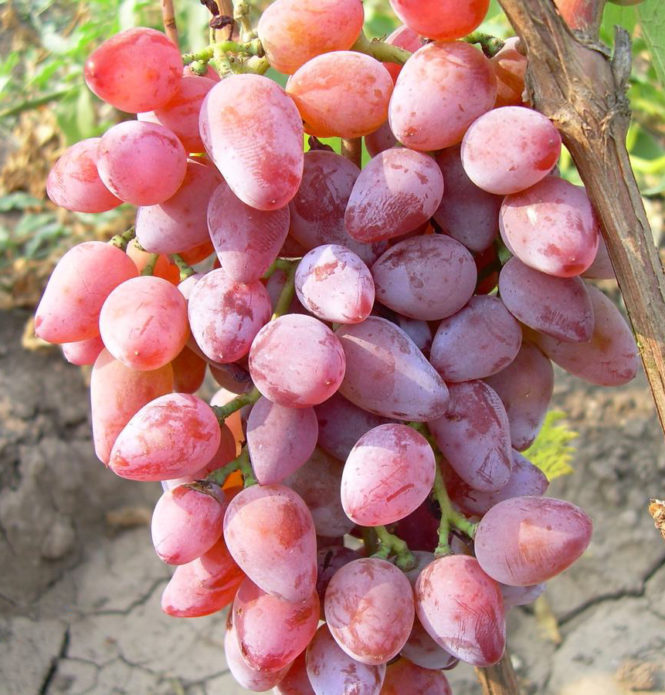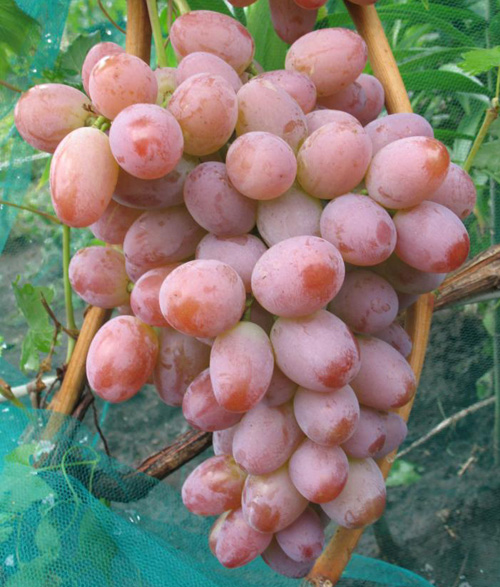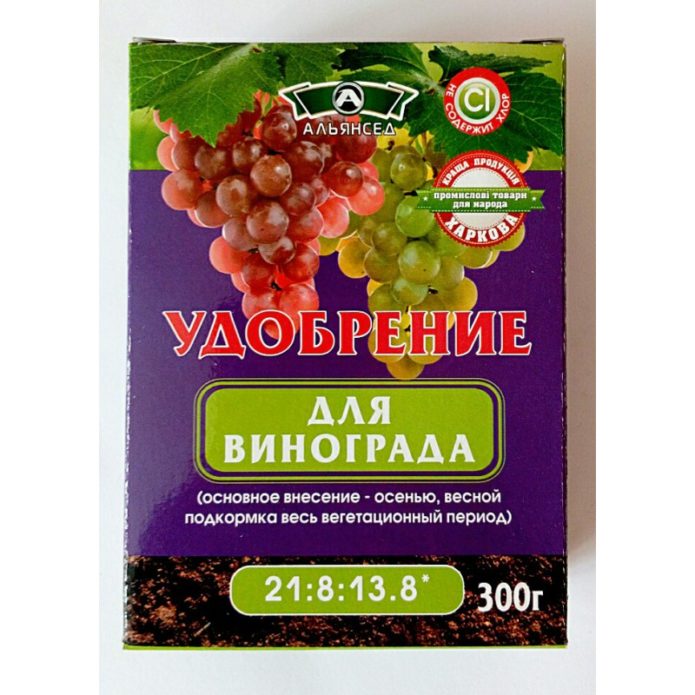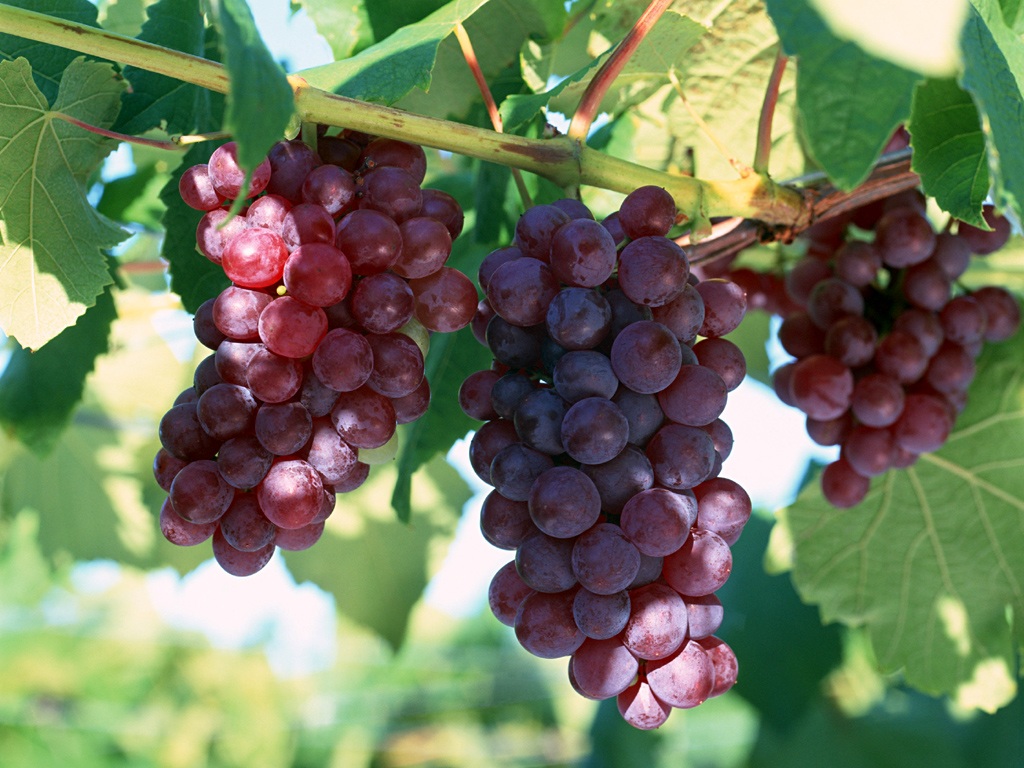Rumba grapes are a fairly young variety of very early ripening period, characterized by unpretentious care and excellent commercial properties of berries. Due to its frost resistance, it is suitable for central Russia, it is equally in demand both in private gardens and in industrial viticulture.
Content
Breeding history, description and characteristics of the Rumba grape variety
Rumba grapes are the brainchild of the famous amateur breeder Vasily Ulyanovich Kapelyushny from the Rostov region. The breeder was engaged in the breeding of grape varieties with large fruits and a complex of resistance to diseases and high frost resistance. The super-early ripening variety Rumba fully meets these requirements.
VU Kapelyushny was a mechanical engineer in his main specialty, for a long time he worked in his specialty. But from a young age he was engaged in the cultivation of grapes on his site, and at the end of the 20th century he finally switched to working with grapes and breeding new varieties. Many decent varieties have come out of his hands, and Rumba is one of them.
The variety was obtained by crossing the famous varieties Red and Cherrel Rapture. Immediately after the recognition, Rumba was zoned in the southern regions, primarily in the Rostov region. However, good frost resistance allows you to successfully grow this variety much further north, in the central regions of our country.
Rumba bushes are very tall and fast growing: in one summer, young shoots can reach six meters in height. At the same time, under conditions of normal care, the ripeness of shoots along the length is almost 100%. The variety is undemanding to the composition of the soil and other growing conditions, easily tolerates long dry periods. Frost resistance is quite high: the temperature limit declared by the author is -25 ºС, although some growers believe that this figure is slightly exaggerated. High resistance to the main diseases: mildew, oidium, various rot.
Rumba is distinguished by its early maturity: two years after planting, the first berries appear. The yield is high and regular. The variety is self-fertile: it contains bisexual flowers and does not require replanting bushes of another variety for pollination. A little more than three months pass from the moment the first buds open to harvest, and in warm regions the berries are ready by the very beginning of August.
The bunches are large, cylindro-conical, on average, almost reaching a kilogram, only some representatives grow up to 1.5 kg. The packing of berries in bunches is not very dense, medium friability. And the safety of berries both on the bushes and in the assembled form, and their transportability are high: no more than 5% of the goods are rejected for long-distance transportation.
Berries are oval, large, weighing up to 10 g.The usual size of the berry is about 32 x 24 mm. The color is red-pink, with a coral tint. There is a slight waxy coating. The skin is comparatively dense, it is felt when the berries are consumed, imparting some astringency to the taste. The pulp is dense, juicy, crunching a little when eaten.
The taste is considered harmonious, but nevertheless sweet tones prevail, since with a high sugar content (up to 23%), the acid content is quite standard: from 5 to 7 g / l. Muscat flavor is negligible. In a rainy summer, the taste of the berries deteriorates somewhat, acquiring wateriness. Surprisingly, with such a sugar content, the variety does not belong to the very strongly affected by wasps or hornets.
The purpose of the variety is universal, but since it is one of the first to ripen, it is mainly used fresh. At the same time, the ratio of sugar and acids allows you to get good wines from Rumba.
Video: the first harvest on Rumba bushes
Features of planting and growing grapes
Rumba grapes can be recommended even for novice gardeners, since caring for them is simple. Both planting and basic care principles differ little from planting and growing other early table varieties. Rumba is a good grape variety with high frost resistance.
The ideal soil for growing grapes is considered to be rich in nutrients, but the variety can grow in any soil. This sets it apart from many other grape varieties. For landing, you need to choose the sunniest area, closed from cold winds, especially the northern direction. A tall house, a solid fence, mature fruit trees, etc. can serve as protection from the winds.
Rumba can be planted with a cuttings, this is one of the simplest methods of propagation, cuttings take root perfectly. When choosing a ready-made seedling, you need to choose a specimen that has well-developed roots, then there will be no problems with the survival rate of the seedling. In the south, grapes are planted in spring and autumn; in the middle lane, it is desirable to do this in April.
If more than one grape bush is planted, the minimum distance to a neighbor should be three meters; the same distance to any nearby bushes.
Last summer, you need to dig up the selected area, adding the most common fertilizers to it, and in the fall, dig a planting hole. A pit for this grape is dug with dimensions of at least 80 x 80 cm, and many experts advise to increase it to a meter. A drainage layer (crushed stone or broken brick) is placed on the bottom and a thick pipe is drawn there for watering the roots in the first few years. The bottom layer in the pit is well fertilized fertile soil, and above it is soil without fertilizers. Grapes are planted deep in spring, but so that the young roots are in clean soil, where there is no fertilizer. 1-2 buds are left on the surface, watered, mulched.
Rumba care consists of watering, feeding, pruning, preventive spraying. Among these activities, the most difficult thing is qualified pruning, the rest of the operations are familiar even to a novice summer resident.
Watering is needed infrequently, stagnant water only harms the grapes. Watering is most important during the growth of the berries, and you do not need to water a month before harvesting. Usually, sub-winter watering is also required, especially if the fall is too dry.
It is mainly necessary to feed with ash: annually apply 1-2 liters under the bush. A year later, early spring fertilization with humus will not hurt; it is buried in small trenches. In addition, it is necessary to carry out foliar dressing by spraying the leaves. Before flowering and immediately after it, weak solutions of mineral complex fertilizers should be used, and then nitrogen is excluded from the formulation.
Rumba has good resistance to grape diseases, but it is advisable to carry out preventive spraying with a solution of ferrous sulfate in early spring.Along the green cone, that is, at the time of the beginning of the opening of the kidneys, you can process it with 1% Bordeaux liquid. Shortly before flowering, the vineyard is treated with Ridomil Gold.
Spring pruning of Rumba is dangerous: sap flow begins very early, so in the spring it is necessary to remove only clearly dead sections of the vine. In the summer, it is necessary to constantly break out excess green shoots and stepchildren while they are young. It is recommended to remove the extra bunches, leaving no more than two on each shoot. Any overload of the harvest dramatically reduces the quality of the berries. The main pruning is in autumn, before the bushes are sheltered for the winter. The variety requires not too short pruning of shoots, 6-8 eyes. No more than 40 buds are left on the bush.
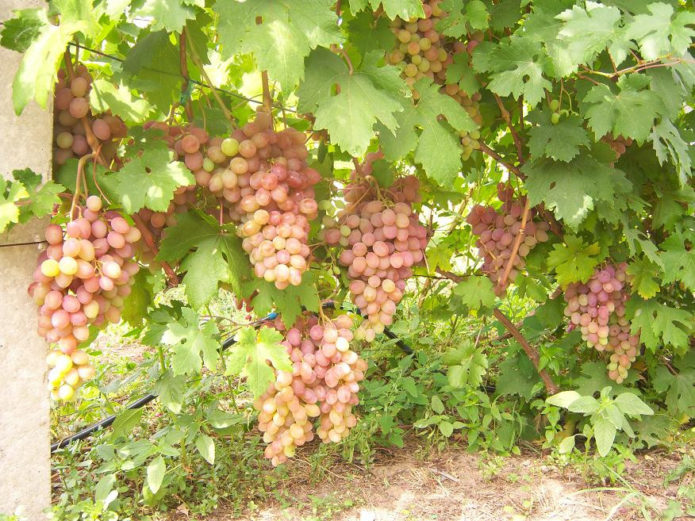
Rumba clusters on the bushes look impressive, but you can't leave too many of them: the bush may not have enough strength to fully ripen
Rumba is not much gnawed by wasps and other flying insects, and the fight against them is not a concern, but in some cases pests attack this variety. It is usually sufficient to remove the nests that the wasps build in the vineyard.
Before the onset of frost, the bush must be removed from the supports and the shoots must be spread on the ground so that it is convenient to cover them. There is no need to bury these grapes in the ground, even in the middle lane. In regions with not too severe frosts, spruce branches of coniferous trees are used; in harsh climates, non-woven materials or pieces of roofing material can be added. It is imperative to scatter rodent control preparations under the bush.
Video: grower about the Rumba variety
Advantages and disadvantages of the variety in comparison with similar
If we compare Rumba with other varieties of V.U. Kapelyushny, then the breeder himself did not consider it his best variety, highlighting Sensation among the early varieties. However, knowledgeable people say that V.U. Kapelyushny was very demanding of the results of his work, sought to correct all possible shortcomings. Therefore, Rumba in the company of very early grape varieties, in general, has undeniable advantages. Chief among them are the following:
- high frost resistance;
- high annual yield;
- excellent transportability of the crop;
- very early and simultaneous ripening of berries;
- excellent presentation and taste of fruits;
- ease of reproduction and care;
- the volume of flowers, allowing you to plant only one bush on the site;
- good resistance to disease.
Among the relative disadvantages, experts include:
- small peas, that is, the presence in bunches, along with large fruits, and nondescript small berries;
- the need for rationing the crop: without removing unnecessary bunches of berries, the berries become much smaller;
- the need to shelter bushes for the winter; in fact, this has to be done for the vast majority of cultivated grape varieties.
Despite these shortcomings, the Rumba variety fell in love with most specialists both in the south of our country and in more severe regions.
Gardeners reviews
In the second year, the self-rooted sapling did not yield, it was "born" only in the third. We left 20 bunches. It ripened completely (both color and sugar) for our zone very early on August 3 (4 days earlier than Libya), there was no acid in the taste initially, and after August 10 it became excessively sweet, already cloying - not for everybody, also with full ripening, a slight astringency of the skin appeared, which, although eaten, is still a bit thick. I tried today a bunch left for visitors - it seemed that the astringency was almost invisible. The pulp is fleshy, a little watery, probably the heat affects. There were no burns on the berry, unlike other varieties and forms! I consider the advantages of this form: ripening period, excellent marketable color, average 700-800 g semi-friable bunches, absence of sunburn of berries, excellent ripening of the vine and a very serious argument for us - neither the wasp nor the hornets touch.
GF Rumba berries were already sweet in early August, that is, they fully correspond to the stated ripening period: very early.The bush is own-rooted, vigorous, with good disease resistance: for two years I have not observed any signs of disease. I can't say anything about frost resistance - the whole vineyard is covered ... The form is very fruitful: firstly, the main harvest was decent both in quality and quantity: all the clusters are beautiful and elegant, weighing up to 1 kg. And then it began: each stepchild had a bunch, or even two - at least small, but a lot ... At first I cleaned, but then I see that there is a threat of opening and growth of the main buds - I left everything as it is ... but the most interesting thing is that they matured until the very last bud and relatively early ... Although all treatments in the vineyard had been stopped long ago, there were no signs of disease on young growths. But there was a lot of stepchild's harvest until the last, before the frost we feasted on Rumba berries - they did not lose sugar and their juiciness. And also a delicate grape aroma was felt in the taste.
Gorgeous form !!! My Rumba ripened by the first days of August. We ate the last bunches of stepchildren in mid-September ... It keeps well on the bush, the wasps do not touch it. I recommend everyone to have this tasty treat on their plots ...
In my already spoiled taste, she is rather simple. But it feels like a very reliable grape.
Video: the grower's opinion on the Rumba variety
Amateur grapes of the Rumba selection are distinguished by a very early ripening period and unsurpassed commercial qualities of berries. Due to its excellent transportability, it is used not only in summer cottages, but also in the gardens of farmers growing grapes for sale. High productivity and self-fertility allow the summer resident to plant only one of his bush on the site, than to meet the family's needs for grape berries.
